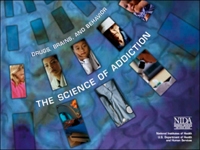Topics in Brief: National Institute on Drug Abuse
Published February 2005
The National Institute on Drug Abuse (NIDA) is the Federal focal point for research on drug abuse and addiction. Established in 1974, NIDA became part of the National Institutes of Health, Department of Health and Human Services, in October 1992. NIDA's mission is to lead the Nation in bringing the power of science to bear on drug abuse and addiction. In this regard, NIDA addresses the most fundamental and essential questions about drug abuse—from detecting and responding to emerging drug abuse trends and understanding how drugs work in the brain and body to developing and testing new treatment and prevention approaches. NIDA also strives to rapidly and effectively disseminate research results to various stakeholders to improve prevention and treatment practices in real-world settings.
Scientific advances have revolutionized our understanding of drug abuse and addiction. We now know, for example, that drug addiction is a chronic, relapsing disease that usually begins in adolescence, and that drugs of abuse can cause long-lasting changes in brain structure and function. Some of these changes can persist long after drug use stops. Based on these data, it is clear that drug addiction is a brain disease, expressed in the form of compulsive behaviors. The good news is that research also shows that addiction is both preventable and treatable.
NIDA supports a large portion of the world's research on the health aspects of drug abuse and addiction. Our mission encompasses research on all drugs of abuse, both legal and illegal, except research with a primary focus on alcohol. Priority areas of research for NIDA include:
- Using new technologies, such as brain imaging, to further our understanding of brain and behavioral development, addiction, and its consequences.
- Uncovering genetic and environmental factors that predict vulnerability to addiction and treatment response.
- Addressing health disparities and vulnerabilities among different populations (e.g., adolescent, minority, and elderly populations).
- Applying knowledge gained from basic and cognitive neuroscience to develop improved prevention and treatment strategies.
- Developing and testing new medications and behavioral therapies to treat addiction.
- Studying the links between addiction and other diseases, including other mental disorders and HIV/AIDS.
Major NIDA Accomplishments
Identifying the molecular sites and systems in the brain where every major drug of abuse has its effect
Such discoveries have led to the development and approval of nicotine replacement therapies for cigarette smoking cessation and new medications like buprenorphine, now prescribed by physicians in office settings, for opiate addiction.
Discovering a new communications network that opens the way to novel medical therapies
NIDA-supported research was pivotal to the discovery of a cannabinoid system distributed throughout the brain and body and composed of the body's own compounds chemically related to marijuana's active ingredient. This network promises new and novel interventions for a range of diseases and conditions, including: addiction, obesity, pain, osteoporosis, multiple sclerosis, and anxiety disorders.
Demonstrating that addiction is a treatable disease
Medications and behavioral therapies can provide long-lasting benefits for people trying to overcome addiction, especially when used together. Addiction treatment promotes continued abstinence, which can reverse some of the detrimental brain changes caused by addiction, as shown in pioneering imaging studies. Successful drug abuse treatment also reduces crime and other societal costs, including health costs, now in the billions.
Optimizing research findings to create individually tailored treatments
Researchers are taking advantage of ongoing discoveries from the Human Genome Project, identifying genetic markers and epigenetic marks of complex disorders like addiction. Now, gene variants are being discovered that can predict who will respond to a medication and who will not. And epigenetic research is slowly piecing together the many ways in which the environment can influence gene expression and function. These breakthroughs herald a new era of individualized therapies that will optimize outcomes, promote cost-efficiency, and relieve suffering.
Decreasing the spread of HIV
Through the development of addiction treatments focused on injection drug use (IDU), NIDA has contributed to the decline in IDU-associated HIV infections. Innovative community-based research shows that drug abuse treatment reduces risk behaviors leading to HIV transmission; thus, drug abuse treatment is HIV/AIDS prevention.
Changing the course of drug abuse treatment in this country
NIDA engages in myriad efforts to "translate" the results of basic and clinical research for real-world use. Our goal is to get research-based treatments into the hands of providers in community treatment centers, jails, and physicians' offices. To that end, NIDA has established collaborative networks of researchers and practitioners, Federal Agencies, and State Substance Abuse Directors to integrate research findings into drug abuse treatment settings nationwide.



